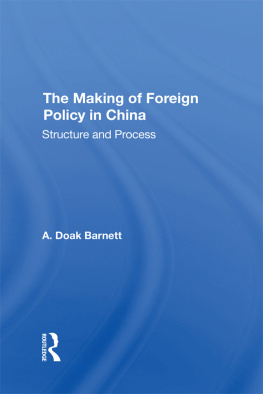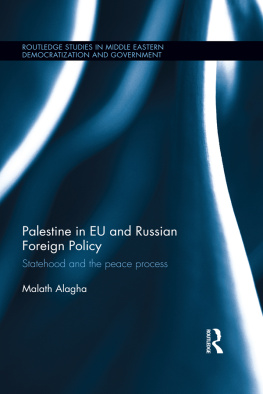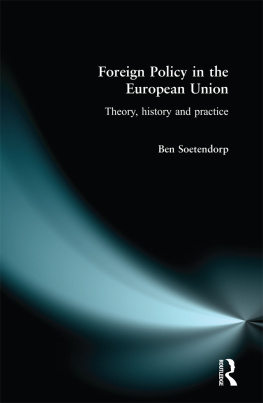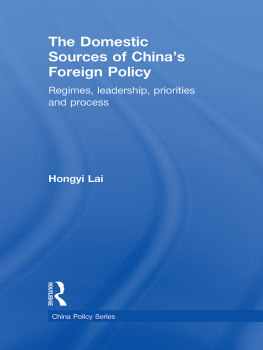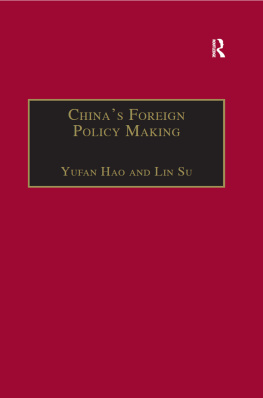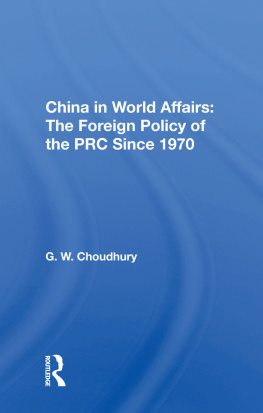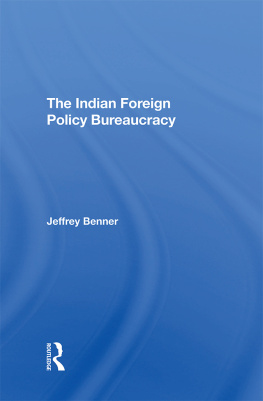SAS PAPERS IN INTERNATIONAL AFFAIRS
The Making of foreign Policy in China
Number 9
SAIS PAPERS IN INTERNATIONAL AFFAIRS
The Making of Foreign Policy in China
Structure and Process
A. Doak Barnett
First published 1985 by Westview Press
Published 2019 by Routledge
52 Vanderbilt Avenue, New York, NY 10017
2 Park Square, Milton Park, Abingdon, Oxon OX14 4RN
Routledge is an imprint of the Taylor & Francis Group, an informa business
Copyright 1985 by The Johns Hopkins Foreign Policy Institute, School of Advanced International Studies (SAIS)
All rights reserved. No part of this book may be reprinted or reproduced or utilised in any form or by any electronic, mechanical, or other means, now known or hereafter invented, including photocopying and recording, or in any information storage or retrieval system, without permission in writing from the publishers.
Notice:
Product or corporate names may be trademarks or registered trademarks, and are used only for identification and explanation without intent to infringe.
Library of Congress Cataloging in Publication Data
Barnett, A. Doak.
The making of foreign policy in China.
(SAIS papers in international affairs)
Bibliography: p.
Includes index.
1. ChinaForeign relations1976- . I. Title.
JX1570.B37 1985 327.51 85-3319
ISBN 13: 978-0-367-29370-3 (hbk)
The Johns Hopkins Foreign Policy Institute
Harold Brown
Chairman
Simon Serfaty
Executive Director
Robert E.Osgood
Director of Research Codirector, Security Studies Program (on leave)
Archie Albright
Executive-in-Residence
Kristen E. Carpenter
Managing Editor Publications Program
Philip Geyelin
Editor-in-Residence
Michael Vlahos
Codirector Security Studies Program
Wilfrid Kohl
Director International Energy Program
George R. Packard
Dean, School of Advanced International Studies, The Johns Hopkins University
The Johns Hopkins Foreign Policy Institute (FPI) was founded in 1980 and serves as the research center for the School of Advanced International Studies (SAIS) in Washington, D.C. The FPI is a meeting place for SAIS faculty members and students, as well as for government analysts, policymakers, diplomats, journalists, business leaders, and other specialists in international affairs. In addition to conducting research on various policy-related international issues, the FPI sponsors conferences, seminars, and roundtables.
The FPI's research activities are often carried on in conjunction with SAIS's regional and functional programs dealing with American foreign policy, Latin America and the Caribbean Basin, Africa, the Middle East, the Soviet Union, U.S.-Japan relations, Canada, security studies, international energy, the Far East, Europe, and international economics.
FPI publications include the SAIS Review, a biannual journal of foreign affairs, which is edited by SAIS students; the SAIS Papers in International Affairs, a monograph series which is copublished with Westview Press in Boulder, Colorado; and, the FPI Policy Study Briefs, a series of analyses on foreign policy issues as they develop. For additional information regarding FPI publications, write to: FPI Publications Program, School of Advanced International Studies, The Johns Hopkins University, 1740 Massachusetts Avenue, N.W. Washington, D.C. 20036.
About the Book and Author
Until recently, Westerners have not adequately understood the structure of the PRC's policymaking process in the post-Mao period. Dr. Barnett's pathbreaking study provides comprehensive information on how China's foreign policy decisions are made. The author draws not only on his past research but also on intensive interviews conducted during 1984 with a wide range of Chinese officials (including Premier Zhao Ziyang), academics, and journalists to describe a major shift in top-level decision making from the Politburo and Standing Committee to the Party Secretariat and State Council. He analyzes the foreign-policy roles of various specialized party and government organizations, as well as the roles of key government ministries and the military establishment, and discusses not only the institutions and individuals involved in the policy process but also the sources of information and analyses on which their decisions are based, including major press organizations, research institutions, and universities. Taking advantage of the new openness of both leaders and working-level specialists in the PRC, Dr. Barnett has written the most detailed and up-to-date study available.
One of the most distinguished China experts of our time, A. Doak Barnett was professor of government at Columbia University and a senior fellow of the Brookings Institution. He is now professor of Chinese Studies at the School of Advanced International Studies at The Johns Hopkins University.
- CASS Chinese Academy of Social Sciences
- CPIFA Chinese People's Institute of Foreign Affairs
- MOFERT Ministry of Foreign Economic Relations and Trade
- NCNA New China News Agency
- NPC National People's Congress
- PLA People's Liberation Army
- YCL Young Communist League
THIS VOLUME PRESENTS in systematic form information I have gathered during the past two years on the structure and process of foreign policy making in China. Although I have studied Chinese foreign policy continuously for thirty-five years and have written a number of books and articles on the subject, until recently I, like most of my colleagues, have known very little about how and where foreign policy is made in Peking. Starting in 1982, however, I found that more and more Chinese, both officials and scholars, were willing to discuss certain aspects of foreign policy making, so I decided to gather data on the subject, primarily through interviews and conversations with knowledgeable Chinese. In 1984 I proposed to the Chinese Academy of Social Sciences that I visit Peking specifically to interview people in the Communist Party and the government, academic and research institutions, and press organizations on this subject. The academy invited me to make the visit, and its staff was extremely helpful in arranging a wide range of meetings in Peking during July and August 1984. This study is based primarily on what I learned during the past two years, especially from the interviews.
The study analyzes the structure and process of foreign policy making, focusing on the institutions and individuals involved. In addition, it throws some new light on the policy-making process in a broad sensethat is, on where, in the Party and governmental structure, foreign policy issues are dealt with, what kinds of relationships exist among the institutions involved, who some of the key policymakers are, and where they obtain information and analyses on the basis of which to consider foreign policy issues. The study helps clarify who is involved and where foreign policy is made. Why and how specific foreign policy decisions are made is much more difficult to determine. However, because of the increasing openness of the Chinese about discussing policy-making in Peking, it may be easier in the period ahead to learn more about specific decisions as well as about the structure and general process that led to them.
In discussing the roles and relationships of institutions of special importance in the policy-making process, I identify some of the key individuals involved and discuss briefly their backgrounds and careers. The data I obtained on top Party and government leaders are from published biographical sources (cited in my notes); much of the information on other individuals discussed in the study came from the interviews in Peking. The profile of the leadership involved in policy-making should be regarded as a snapshot of the situation in mid-1984. At this writing, some personnel changes have already taken place (a number of these are indicated in my footnotes), and in the immediate period ahead there will be many more. However, these changes are likely to be in line with major trends discussed in the studythat is, toward a more technocratic top leadership increasingly composed of individuals with specialized knowledge and administrative experience in particular fields and toward greater professionalism at lower levels.


